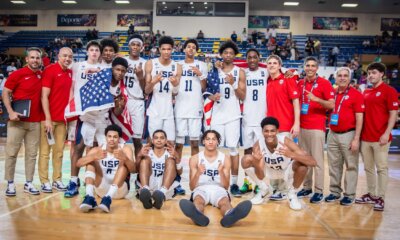The announcement on Tuesday that Diana Taurasi would skip the 2015 season for the Phoenix Mercury came with almost immediate calls to do something about the WNBA’s salary structure.
Taurasi’s decision to sit out the summer after 10 mostly non-stop years of professional basketball — and prompted by her Russian club’s willingness to pay more than her WNBA season salary while she rests — is a stark reminder of the financial disparities of the global professional basketball market for women.
The former UConn All-American makes an estimated $1.5 million for UMMC Ekaterinberg, where she plays for what’s arguably the best team in the world and averages a team-high 17.9 points. The rest of the starting lineup: Candace Parker, Deanna Nolan, French national team star Sandrine Gruda and Alba Torrens, a top international guard from Spain.
After speaking with Taurasi on Tuesday, Kate Fagan of espnW concluded:
“The WNBA needs to figure out a way to better compensate the players who actually move the needle. Taurasi is worth much more than $107,000 a year to the WNBA.
“But is playing in the WNBA worth $107,000 to Taurasi?”
For this season, obviously not.
The timing of her departure, coming off the Mercury’s dominating route to the WNBA title last season, also is unfortunate. The Phoenix nucleus of Taurasi, Brittney Griner, DeWanna Bonner, Candice Dupree and Penny Taylor might be the second-best women’s club team on the planet.
Fans in Phoenix and around the league will be deprived of one of the most dynamic players the game has ever known. But conflicting schedules with overseas clubs has been an issue since the WNBA launched.
(Skeptics/cynics might also point out that Taurasi played limited action in 2012 due to ankle and hip flexor injuries on either side of the London Olympics, although she seemed fine leading the USA to another gold medal. The Mercury sunk into the draft lottery, got the No. 1 pick and chose Griner.)
Taurasi is not the first WNBA player to take such a hiatus — Nolan hasn’t played stateside since 2009 — but she is the most notable. The concern is that this move may start a precedent with elite (mostly American) players, and this is understandable.
But at the age of 32, and entering the twilight of her career, Taurasi is also eyeing the end of the road, and what’s certain to be her final Olympics in 2016. Maximizing earnings with what’s left of a healthy body means everything to any elite athlete.
Remember how Taurasi’s career was threatened in 2010 by what turned out to be a botched doping test? She hired Howard Jacobs, a noted attorney who represents athletes in doping cases, to clear her, but it cost her a contract with the Turkish club Fenerbahçe.
Her generation of WNBA stars that includes Lauren Jackson, Sue Bird and Tamika Catchings is being replaced by Parker, Griner, Maya Moore, Angel McCoughtry, Tina Charles, Elena Delle Donne, Skylar Diggins, the Ogwumike sisters and other twenty-somethings.
The fear is that some of those players may follow the same path as Taurasi, and perhaps earlier in their careers. The greater fear is that this may indicate something about the viability of the WNBA.
Any seismic move affecting the WNBA tends to be regarded this way. Since its inception in 1997, the demise of the WNBA has been periodically predicted, as teams relocated or folded and television ratings and attendance foundered.
But like David Stern before him, NBA commissioner Adam Silver has been a stalwart supporter of the WNBA (for a time he led the WNBA’s daily operations). The WNBA will be around as long as Silver wants it to. But as Stern’s tenure was ending, NBA officials were clear that they wanted the women’s league to become more self-sustaining.
The 12 WNBA franchises, like others in North American sports, have something of a business model that’s based generally on what the market of ticket-buying customers and television viewers will support.
Like Major League Soccer — which also plays in the summer — salaries are tightly capped. Unlike the men’s soccer league, however, the WNBA doesn’t have a limited number of “designated players” who are allowed to earn far more than that cap. That is how MLS was able to sign David Beckham, for example, and showcase American stars like Landon Donovan and Clint Dempsey.
I don’t know whether WNBA finances will ever allow something like that, and it may take more than just Taurasi sitting out to prompt a change that dramatic. A new CBA with fines for missing games due to overseas commitments kicked in last year, so any alterations won’t happen anytime soon.
What’s also interesting to note is a change of leadership with the WNBA players’ union. Longtime operations director Pam Wheeler was removed from her post in December by NBAPA executive director Michele Roberts, who’s taken over on an interim basis.
In the wild west environment of international club teams, professional women’s basketball really has no business model. UMMC is owned by a billionaire in Ekaterinberg, a wealthy metropolis made that way by the mineral and natural gas industries plying the nearby soil of Siberia.
Taurasi previously played for Spartak Moscow, which was owned by Shabtai Kalmanovich, a former KGB agent who treated his players — including Bird — like queens. This was a man for whom money was no object, and he wasn’t concerned with how many rubles were spent on a women’s team that routinely drew less than WNBA teams. Said Taurasi in 2007:
“There are six or seven owners [like him] in Russia. They’re hotheads who want the best women’s basketball team, and that’s their hobby, so they don’t care how much they pay.”
After Kalmanovich was assassinated two years later, his hoops plaything was downsized considerably, and today features Russian players presumably making nothing close to what Taurasi pulls down.
Paul Nilsen, who writes extensively about women’s international basketball, warned last year that the WNBA might be seen as a luxury by top-tier players balancing multiple professional leagues and national team demands, “a three-pronged dynamic” that’s hard to sustain:
“The WNBA has always appeared untouchable, but I think salaries on offer elsewhere are beginning to squeeze the lure it holds – along with the way women’s basketball and the athletes themselves are evolving.”
But given its business model, what can the WNBA really do? While there may be some more hand-wringing about elite players “deserving” more money — and I agree that they do — the financial stability of the league is paramount. Even doubling the league maximum probably wouldn’t have prevented Ekaterinberg from making Taurasi an offer she couldn’t refuse.
On their Twitter feeds, retired Indiana Fever coach Lin Dunn and Cheryl Reeve of the Minnesota Lynx didn’t seem concerned that Taurasi’s decision would start a trend. I hope they’re right.
Frankly, I was more worried when Paula Madison gave up on the Los Angeles Sparks this time last year. A last-minute rescue by Magic Johnson and his business partners saved that charter franchise from relocation or worse.
Now, the Sparks have hired Brian Agler from the Seattle Storm, a venerable, well-supported franchise going through changes on and off the court. Jackson and Bird are nearing the end of their careers, and longtime general manager Karen Bryant has departed.
These aren’t the kinds of developments that make news beyond the WNBA community, but I think they’re just as critical, if not more so, than a high-profile player taking the season off.
As I finish this piece, I note that today is National Girls and Women in Sports Day in the United States. While the WNBA may never make a lot of hay outside of the female basketball world, it has inspired a lot of young girls to imagine having a professional career, as modest as it may seem.
While the bulk of those careers may take place beyond American shores, it’s worth celebrating on this day that a domestic league, however constrained, has helped to make something like this possible.
I was skeptical when the WNBA first came around and its future is not guaranteed, but it has been an important addition to the growing landscape of women’s sports in this country. Diana Taurasi has been a signature player in its history, and she will be missed this summer. But the league is far bigger than one player.
Wendy Parker is a sportswriter and web editor who has covered women's basketball since the early 1990s. She is a correspondent for Basketball Times and formerly covered women's and college sports, soccer and the Olympics at The Atlanta Journal-Constitution. She is the author of "Beyond Title IX: The Cultural Laments of Women's Sports," available on Amazon, and the creator of Sports Biblio, a blog about sports books and history.

Latest Articles
-


Christopher Lawlor
/ 9 hours agoUSA defeat Canada in FIBA U16 AmeriCup Final to lift the trophy for ninth time with a perfect mark; Nasir Anderson earns Most Valuable Player
CIUDAD JUAREZ, Mexico – The FIBA U16 AmeriCup 2025 throne has the United States’...
-
Christopher Lawlor
/ 3 days agoSPEARHEADED: Americans crush Brazil by 79 points at FIBA U16 AmeriCup quarterfinals; Marcus Spears Jr. puts up 16 points and 9 rebounds
JUAREZ, Mexico — The USA men passed its first test in the knockout stage...
-


Christopher Lawlor
/ 5 days agoSTARS SHINE: Bailey, Costello earn Co-MVPs at 23rd Pangos All-American Camp in Las Vegas; three Santa Margarita (CA) players recognized
LAS VEGAS – The Pangos All-American Camp did not disappoint. For three days the...
-


Christopher Lawlor
/ 1 week ago23rd Pangos All-American Camp tips off in Las Vegas with nation’s elite players congregating for national showcase event
LAS VEGAS – The summer circuit is nearly two months old but it really...



